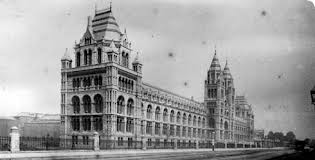Sunday 21 April 2013
SPIRITUALISM, CREATIONISM AND REFORM, SOCIAL HISTORY OR CONTEMPORARY CODE FOR COMMUNITY?
I was interested to read that the Natural History Museum had its 132nd anniversary last week. It is a truly remarkable building with its imposing Romanesque architecture. Construction began in 1871 & was completed in 1881. One can only marvel at the skill of the craftsmen & the sweat of the labourer who built this palatial edifice to life in its myriad forms, extinct or otherwise!
Apparently the museum is home to 70 million items in the fields of botany, entomology, mineralology & paleantology.
The museum has a well beaten track by schoolchildren over the years, a visit here is like the equivalent of entering Ali Baba's cave of treasures, the things one can learn here proffer a tantalising insight into the workings of life, the universe & other small matters! In fact what can be learnt here will be taken by the individual to the grave. A wonderful foundation for the growing mind & perhaps this is not just for kiddies,
there are many adults who would, no doubt, have well rounded lives if they could but realise that life is a continuum of evolving events that place us not at the centre of the universe but as interconnected to the thread of life itself.
The museum has been a constant backdrop in the scenery of South Kensington for the 15 years that I have been at the College of Psychic Studies. I expect it is a little different now, with its Darwin centre, gardens & sweeping external coloured lights....but not that much different.
I am fascinated by timelines & was intrigued by the fact that the museum & the College of Psychic Studies would have been birthed at about the same time. They are neighbours; the museum sitting on Cromwell rd which is literally a step away from Queensberry place, home to the college.
In 1884 the College started out in life as the London Spiritualist Alliance by William Stainton Moses, a cleric & spiritualist. It was a place of experimentation, debate & controversy, although various luminaries of the time would have frequented the building, not everyone approved of the side stepping away from the norms of christian worship.
Perhaps the most notable advocate of eternal life was Arthur Conan Doyle who was president in the 20's & did a lot for the bereaved by supporting the notion of the continuation of life after death.
Another champion of the cause was AR Wallace, also based at the college, a contemporary & peer to Charles Darwin. Wallace was not only an eminent botanist but was dedicated to socio economic reform.
Spiritualism sprang up from a thirst by the educated victorians who found traditional religious doctrine unacceptable but were not satisfied with the materialistic & mechanical view of the world that was emerging form C19 science.
There was a dissatisfaction with the church & its explanation of eternal life. At the same time Darwin (& Wallace) were proving the theory of evolution, natural selection & survival of the fittest.
In many ways that idiom transferred itself on to society & social Darwinism began. Creationism was becoming less credible & as a result the foundations of firmly held beliefs around direct action by God with the individual were being shaken.Victorians were opening up to one's status in life was not appointed by a wrathful deity, perched with pointed finger on a cloud William Blake style but from circumstance & choice.
Spiritualism was a natural vehicle for reform, mainly women. Notably, Victoria Woodhull & Achsa W Sprage (USA) & Emma Hardinge Britten (UK).
Their trance addresses were filled with putting the world to rights through sufferagacy & abolition.
It might be worth mentioning that Robert Owen 1771 - 1858 founder of the Co-operative society & socialist came to spiritualism late in his life & channelled the american president, George Washington.
It would appear that Spiritualism, although received with scepticism in many quarters, was a positive body of movement that earnestly worked to make sense of a changing world, it espoused equality& personal growth & accepted that there was more to life than met the eye.
It embraced the idea that relationships continue & love never dies., still a source of both comfort & intrigue to this day.
Spiritualism as a movement still has a lot to offer to the modern community. The 7 principles are still a bareable structure for life & the fact that someone can stand on a podium & connect others to ideas of divinity without wearing robes of office & awaken the sleeping to the energy of love, can only be a good thing & worth preserving & upholding.
So many have the skills to heal & can offer insights of the benevolent Great Spirit not for the sake of hinderance but for improvement, it seems only appropriate that the churches & centres make conscious efforts to bring these gifts into the wider community at large.
Many places do this already but there is still much scope, room for invention & imaginitive purpose.
Reform is not a thing of the past, evolution is in a constant state of flux. In these interesting times we inhabit, it is surely worthwhile to embrace the path of our forebears & bring these fine ideals into the modern age.
Subscribe to:
Posts (Atom)
